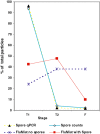Bioaerosol sampling for the detection of aerosolized influenza virus
- PMID: 19453416
- PMCID: PMC4941879
- DOI: 10.1111/j.1750-2659.2007.00020.x
Bioaerosol sampling for the detection of aerosolized influenza virus
Abstract
Background: Influenza virus was used to characterize the efficacy of a cyclone-based, two-stage personal bioaerosol sampler for the collection and size fractionation of aerosolized viral particles.
Methods: A Collison single-jet nebulizer was used to aerosolize the attenuated FluMist vaccine into a calm-air settling chamber. Viral particles were captured with bioaerosol samplers that utilize 2 microcentrifuge tubes to collect airborne particulates. The first tube (T1) collects particles greater than 1.8 microm in diameter, while the second tube (T2) collects particles between 1.0 and 1.8 microm, and the back-up filter (F) collects submicron particles. Following aerosolization, quantitative PCR was used to detect and quantify H1N1 and H3N2 influenza strains.
Results: Based on qPCR results, we demonstrate that aerosolized viral particles were efficiently collected and separated according to aerodynamic size using the two-stage bioaerosol sampler. Most viral particles were collected in T2 (1-1.8 microm) and on the back-up filter (< 1 microm) of the bioaerosol sampler. Furthermore, we found that the detection of viral particles with the two-stage sampler was directly proportional to the collection time. Consequently, viral particle counts were significantly greater at 40 minutes in comparison to 5, 10 and 20 minute aerosol collection points.
Conclusions: Due to a lack of empirical data, aerosol transmission of influenza is often questioned. Using FluMist, we demonstrated that a newly developed bioaerosol sampler is able to recover and size fractionate aerosolized viral particles. This sampler should be an important tool for studying viral transmission in clinical settings and may significantly contribute towards understanding the modes of influenza virus transmission.
Figures



References
-
- Lewis DB. Avian flu to human influenza. Annu Rev Med 2006;57:139–154. - PubMed
-
- Bridges CB, Kuehnert MJ, Hall CB. Transmission of influenza: implications for control in health care settings. Clin Infect Dis 2003;37:1094–1101. - PubMed
-
- Belshe RB. The origins of pandemic influenza–lessons from the 1918 virus. N Engl J Med 2005;353:2209–2214. - PubMed
Publication types
MeSH terms
Substances
LinkOut - more resources
Full Text Sources

